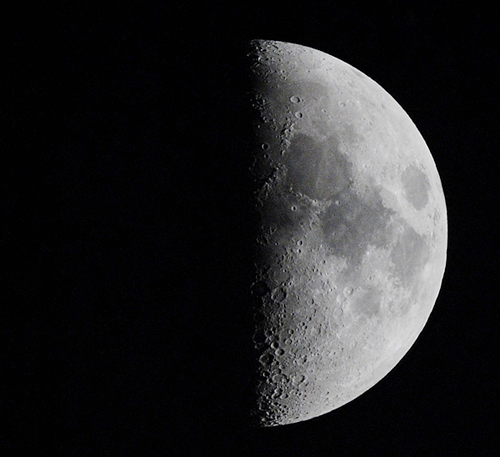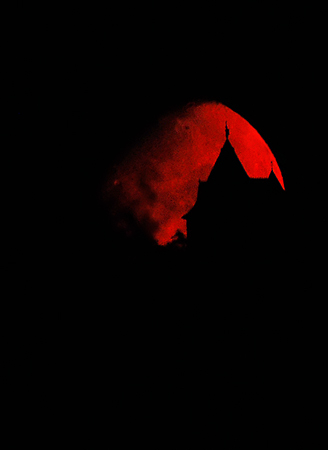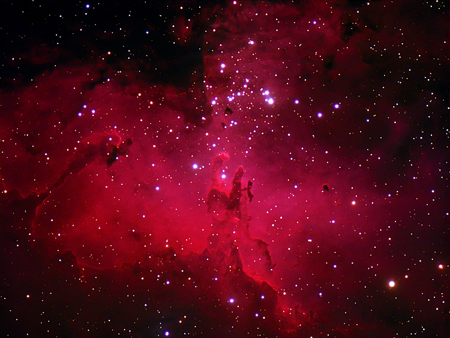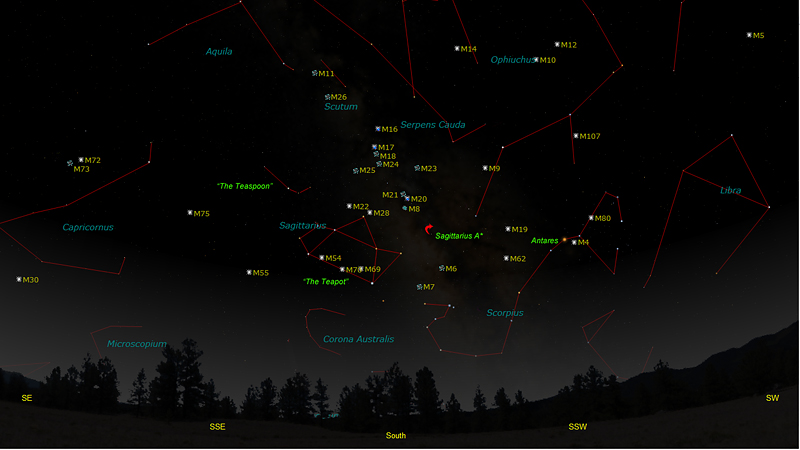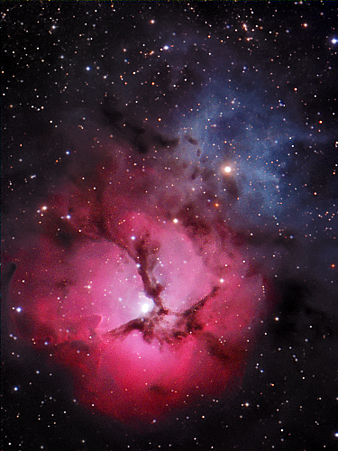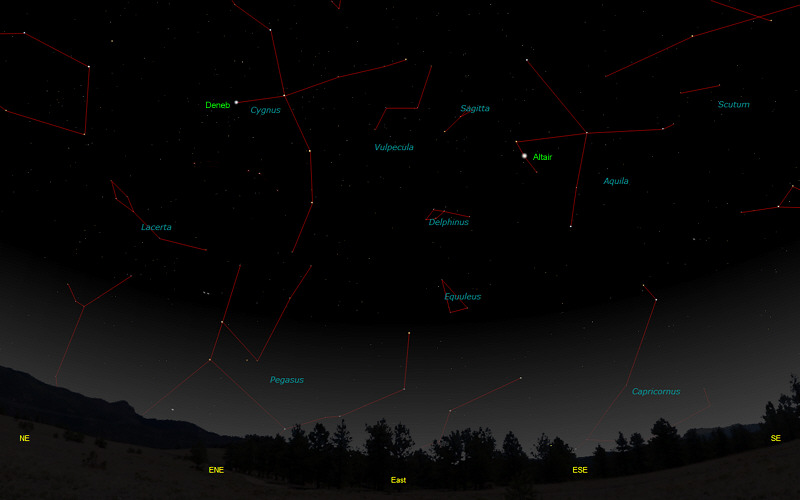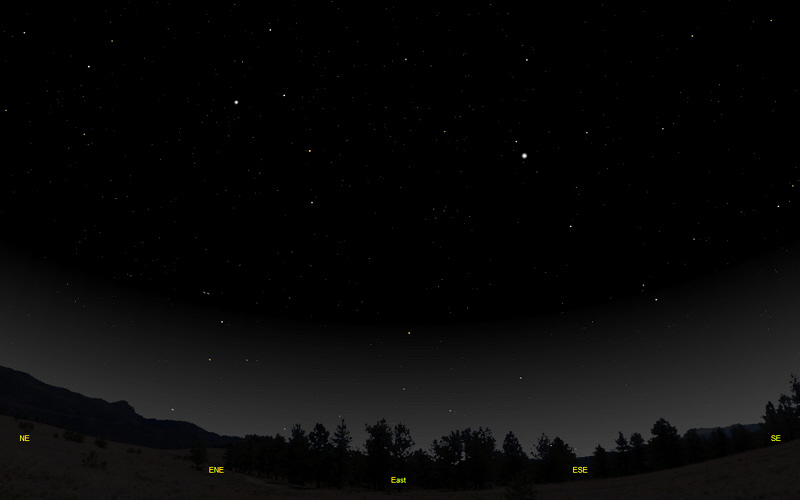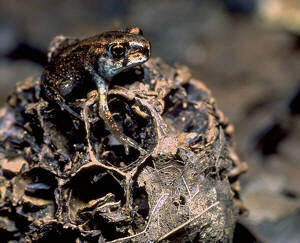The purpose of this feature is to give scout leaders, educators and naturalists an idea of some of the natural events coming up each month. We will try to cover a variety of natural events ranging from sky events to calling periods of amphibians, bird and mammal watching tips, prominent wildflowers and anything else that comes to mind. We will also note prominent constellations appearing over the eastern horizon at mid-evening each month for our area for those who would like to learn the constellations. If you have suggestions for other types of natural information you would like to see added to this calendar, let us know! Note: You can click on the hyperlinks to learn more about some of the featured items. To return to the Calendar, hit the "back" button on your browser, NOT the "back" button on the web page. All charts are available in a "printer friendly" mode, with black stars on a white background. Left clicking on each chart will take you to a printable black and white image. Please note that images on these pages are meant to be displayed at 100%. If your browser zooms into a higher magnification than that, the images may lose quality. Though we link book references to nationwide sources, we encourage you to support your local book store whenever possible. Notes and Images From June 2011
Summer nights tend to be a little hazier
than other times of the year. While faint galaxies may be harder to spot, it's a great time
to view the Moon and planets. It's easy to overlook how beautiful
the Moon
is as it slowly rises over a distance ridge or nighttime cityscape.
Some of our favorite memories of the Moon are from summer vacations -
times when, relieved from our normal rushing about - we could stop and
really appreciate the view.
We recently encountered a program on the web that is quite good at predicting the exact spot on the horizon at which the Sun or Moon will rise and set on a given day. Called the Sun/Moon Calculator, it was written by Jeff Conrad. With the aid of this program you can pick a landmark and find which dates in the next year that the Sun or Moon will rise or set behind it. We started out by finding a landmark on the horizon that we could see from a couple of miles away. This two mile distance allows for both the Moon and the landmark to be in sharp focus in the image. We chose the Renaissance Castle near Triune, Tennessee for our foreground. Then, working with Google Earth and the Sun/Moon Calculator, we checked to see on which days the Moon set behind the castle from various vantage points. This resulted in our standing beside a road in Williamson County at 1:30am in the morning on June 11th. We had a small refractor with a camera attached, mounted on a fixed tripod. It was a cool morning, and the scent of sweet clover drifted up to us. A Chuck-wills-widow called from the fields. This was our first try, and we weren't sure if we positioned the camera with sufficient accuracy. After all, the width of the above image is not much bigger than the nail of your little finger held at arms length. But we were lucky. Right at the predicted time the reddened Moon slid behind the castle. Few cars passed at that very early hour, and only one slowed and stopped. A window rolled down, and a voice asked, "You guys are cool, right?" A good online atlas for the Moon is at the Inconstant Moon web site.
Sky Events for July 2011: Earth is at aphelion, it's farthest point from the Sun in 2011, on July 4th. Evening Sky: At the beginning of July, look for Saturn about 40 degrees above the southwest horizon. This is a great time to see Saturn, and just about any small telescope will give a great view. Look for Mercury roughly 5 degrees above the western horizon about 45 minutes after sunset during the first three weeks in July. Summer Messier Objects: Looking south on a clear midsummer night yields a treasure trove of Messier clusters and nebulae. The illustration below is made for July 20th at 11:00pm. First, look for Antares, the red giant star that marks the heart of Scorpius, the Scorpion. The name Antares means, "rival of Mars." See if you can trace the tail of the scorpion down almost to the horizon, then back up to the two close stars that mark the stinger. These two stars are sometimes called the "cat's eyes." Due south look for the stars of Sagittarius. The brighter stars form an asterism known as "the teapot." Above the handle of the teapot you can see the four stars that form the asterism known as "the teaspoon." In a dark sky, the clouds of the Milky Way seem to boil out of the spout of the teapot. Above and to the right of the spout of the teapot is the radio source Sagittarius A*. It marks the center of our galaxy. There an enormous black hole with the mass of around 4 million times the mass of the Sun is thought to feed on any stars unlucky enough to wander too close. Nothing unusual is seen visually at this spot, but it's fun to imagine the beast within. This is a beautiful area to scan with binoculars, with many clusters and nebulae. See how far you can trace the Milky Way across the sky (easier if you're far away from city lights). Compare your view of the Milky Way to the image of the edge-on galaxy NGC 4565 we made in April of 2010.
Some of our favorite Messier objects reside in this part of the sky. One of the things that inspired me to build a 6 inch reflecting telescope in high school was an illuminated slide of the Eagle Nebula, M16, that was made by the 200" inch telescope on Palomar Mountain. You won't see the bright colors of these nebulae in a small telescope - the eye is very poor at detecting color at these very low light levels. But it's fun to try to spot the faintly glowing cloud. Another favorite is the Swan Nebula, M17. Here you can see a faint "swan" swimming in a pretty star field. You might also see if you can spot the dark lanes in the Trifid Nebula, M20. A nebula filter will help see detail, but will also tend to alter the appearance of the stars in the field. Above the spout of "the teapot" is Messier 8, the Lagoon Nebula. Don't leave this area without looking at the magnificent globular cluster Messier 22. Look for it slightly above and to the left of the top of the teapot's "lid".
Morning Sky: The Southern Delta Aquarid meteor shower peaks around July 28 through July 30th. This is a historically weak shower. Venus is a brilliant point of light in the eastern dawn sky during the first part of July, but will gradually disappear into the morning glow as the month progresses. Look for it about 30 minutes before sunrise. Mars rises at 3:24am at the beginning of the month in Taurus. Telescopically it is disappointing due to it's very small 4 seconds-of-an-arc apparent size. Jupiter rises about 1:45am at the beginning of the month in Aries. All times noted in the Sky Events are for Franklin, Tennessee and are Central Daylight Time. These times should be pretty close anywhere in the mid-state area. Constellations: The first pair of charts below shows the sky looking east at 10:12pm CDT on July 12th. The first chart shows the sky with the constellation outlined and names depicted. Star and planet names are in green. Constellation names are in blue. The second view shows the same scene without labels. Prominent constellations this month in the eastern sky are Cygnus, the Swan, with its bright star Deneb, and Aquila, the Eagle, with its bright star Altair. Below and to the left of Altair is the constellation of Delphinus, the Dolphin, looking like it's leaping over the eastern horizon. Above Delphinus look for the arrow-like form of Sagitta, the Arrow. Between Sagitta and Cygnus lie the faint stars of Vulpecula, the Fox.
On Learning the Constellations: We advise learning a few constellations each month, and then following them through the seasons. Once you associate a particular constellation coming over the eastern horizon at a certain time of year, you may start thinking about it like an old friend, looking forward to its arrival each season. The stars in the evening scene above, for instance, will always be in the same place relative to the horizon at the same time and date each July. Of course, the planets do move slowly through the constellations, but with practice you will learn to identify them from their appearance. In particular, learn the brightest stars (like Deneb and Altair in the above scene), for they will guide you to the fainter stars. Once you can locate the more prominent constellations, you can "branch out" to other constellations around them. It may take you a little while to get a sense of scale, to translate what you see on the computer screen or what you see on the page of a book to what you see in the sky. Look for patterns, like the stars that make up the constellation Cygnus. The earth's rotation causes the constellations to appear to move across the sky just as the sun and the moon appear to do. If you go outside earlier than the time shown on the charts, the constellations will be lower to the eastern horizon. If you observe later, they will have climbed higher. As each season progresses, the earth's motion around the sun causes the constellations to appear a little farther towards the west each night for any given time of night. If you want to see where the constellations in the above figures will be on August 15th at 10:00pm CDT, you can stay up till 12:00pm CDT on July 15th and get a preview. The westward motion of the constellations is equivalent to two hours per month. Recommended: Sky & Telescope's Pocket Star Atlas is beautiful, compact star atlas. It is destined to become a classic, and is a joy to use at the telescope. A good book to learn the constellations is Patterns in the Sky, by Hewitt-White. You may also want to check out at H. A. Rey's classic, The Stars, A New Way to See Them. For skywatching tips, an inexpensive good guide is Secrets of Stargazing, by Becky Ramotowski. A good general reference book on astronomy is the Peterson
Field Guide,
A Field Guide to the Stars and Planets, by Pasachoff. The book retails for around $14.00. Starry Night has several software programs for learning the night sky. Visit the Starry Night web site at www.starrynight.com for details.
Amphibians:
July’s frogs and toads are much like June’s. Listen for Cope's Gray Treefrogs, Gray Treefrogs, Bird-Voiced Treefrogs, Green Treefrogs and Barking Treefrogs. Northern Cricket Frogs and Southern Cricket Frogs call a lot during July, and the calls of Bullfrogs and Green Frogs fill the night air. After heavy rains listen for the high, insect-like call of the Eastern Narrowmouth Toad and the strange-sounding Eastern Spadefoot. Be sure to look closely at young toads you encounter. Sometimes we find young Eastern Spadefoots foraging during the day. A young Eastern Spadefoot will have vertical pupils, a tiny spade on its rear feet and will often have some red warts, even when only a fraction of an inch long. A hand lens helps to see these features (or turn your binoculars around and use them for a magnifying glass.) Recommended: The Frogs and Toads of North America, Lang Elliott, Houghton Mifflin Co.
Archives (Remember to use the back button on your browser, NOT the back button on the web page!) Natural Calendar February 2011 Natural Calendar December 2010 Natural Calendar November 2010 Natural Calendar September 2010 Natural Calendar February 2010 Natural Calendar December 2009 Natural Calendar November 2009 Natural Calendar September 2009 Natural Calendar February 2009 Natural Calendar December 2008 Natural Calendar November 2008 Natural Calendar September 2008 Natural Calendar February 2008 Natural Calendar December 2007 Natural Calendar November 2007 Natural Calendar September 2007 Natural Calendar February 2007 Natural Calendar December 2006 Natural Calendar November 2006 Natural Calendar September 2006 Natural Calendar February 2006
Natural Calendar
December 2005
Natural Calendar
November 2005
Natural Calendar
September 2005
Natural Calendar
February 2005
Natural Calendar
December 2004
Natural Calendar
November 2004
Natural Calendar
September 2004
Natural Calendar
February 2004
Natural Calendar
December 2003
Natural Calendar
November 2003
Natural Calendar
September 2003 Natural Calendar February 2003 Natural Calendar December 2002 Natural Calendar November 2002 Nature Notes Archives: Nature Notes was a page we published in 2001 and 2002 containing our observations about everything from the northern lights display of November 2001 to frog and salamander egg masses. Night scenes prepared with The Sky 6 Professional from Software Bisque All images and recordings © 2011 Leaps |
||||||||||
